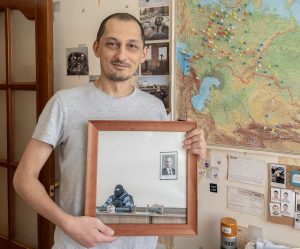Sparks fly as a circular saw slices into metal, while welders nearby work feverishly to the sound of blaring heavy metal. Upstairs, sewing machines clatter as women mark patterns on cloth being shaped into bulletproof vests.
An old industrial complex in the southeastern Ukrainian riverside city of Zaporizhzhia has become a hive of activity for volunteers producing everything from body armor and anti-tank obstacles to camouflage nets, portable heating stoves and rifle slings for Ukrainian soldiers fighting Russia’s invasion. One section specializes in vehicles, armor-plating some, converting others into ambulances. Another organizes food and medical deliveries.
With the front line about 50 kilometers (30 miles) from the city, some sections of the operation, such as the stitching of bulletproof vests, are working around the clock in shifts to meet demand. Crowdfunding has brought in enough money to buy steel from Sweden, Finland and Belgium, which is lighter than local steel, organizers say, a crucial quality for body armor.
Also Read | Mothers Day: United States first lady pays homage to ‘resilient’ Ukrainian moms
The operation is the brainchild of local celebrity Vasyl Busharov and his friend Hennadii Vovchenko, who ran a furniture-making business. They named it Palianytsia, a type of Ukrainian bread whose name many Ukrainians say cannot be pronounced properly by Russians.
The operation relies entirely on volunteers, who now number more than 400 and come from all walks of life, from tailors to craftsmen to lawyers. Apart from those involved in production, there are also drivers delivering humanitarian aid and medical equipment bought through donated funds.
“I feel I am needed here,” said fashion designer Olena Grekova, 52, taking a brief break from marking fabric for vests.
When Russia invaded on Feb. 24, she was in Thailand seeking inspiration for her spring collection. Initially, she said, she wondered whether it was a sign from God that she shouldn’t return. Her husband and two adult sons urged her not to.
Also Read | Al-Qaeda chief blames US for Ukraine invasion in new video
“But I made a decision that I had to go back,” she said.
She had known Busharov for years. Arriving home on March 3, she gathered her equipment the next day and by March 5 was at Palianytsia. She’s been working there every day since, bar one, sometimes even at night.
Shifting from designing backless ballgowns to creating functional bulletproof vests was “a new experience for me,” Grekova said. But she sought feedback from soldiers for her designs, which have armor plates added. Now she is helping to produce several versions, including a prototype summer vest.
In another section of the industrial complex, 55-year-old Ihor Prytula was busy making a new camouflage net, winding pieces of dyed fabric through a string frame. A furniture-maker by trade, he joined Palianytsia at the start of the war. He had some military experience, he said, so it was easy to get feedback from soldiers on what they needed.
Also Read | Why is Russia attacking Ukraine’s railway network? Explained
“We speak the same language,” he said.
For Prytula, the war is personal. His 27-year-old son was killed in late March as he helped evacuate people from the northern town of Chernihiv.
“The war and death, it’s bad, trust me, I know this,” he said. “It’s bad, it’s tears, it’s sorrow.”
The call for volunteers went out as soon as the war began. Busharov announced his project on Facebook on Feb. 25. The next day, 50 people turned up. “Next day 150 people, next day 300 people. … And all together, we try (to) protect our city.”
They started out making Molovov cocktails in case Russian soldiers advanced on Zaporizhzhia. In 10 days, they produced 14,000, he said. Then they turned to producing anti-tank obstacles known as hedgehogs — three large metal beams soldered together at angles — used as part of the city’s defenses. Soon, Busharov and Vovchenko said, they discovered another pressing need: there weren’t enough bulletproof vests for Ukraine’s soldiers.
But learning how to make something so specialized wasn’t easy.
Also Read | Russia blows up bridges to decelerate Ukraine’s counter-attacks: Report
“I wasn’t actually connected with the military at all,” said Vovchenko. “It took two days and three sleepless nights to understand what needs to be done.”
The team went through various types of steel, making plates and testing them to check bullet penetration. Some didn’t offer enough protection, others were too heavy to be functional. Then they had a breakthrough.
“It turns out that steel used for car suspension has very good properties for bullet penetration,” Vovchenko said, standing in front of four shelves of test plates with varying degrees of bullet damage. The one made of car suspension steel showed dozens of bullet marks but none that penetrated.
The vests and everything else made at Palianytsia are provided free to soldiers who request them, so long as they can prove they are in the military. Each plate is numbered and each vest has a label noting it is not for sale.
Also Read | Taiwan keep high hopes on the world if China tries to invade island
So far, Palianytsia has produced 1,800 bulletproof vests in two months, Busharov said, adding there was a waiting list of around 2,000 more from all over Ukraine.
Vovchenko said they have heard about up to 300 people whose lives have been saved by the vests.
Knowing that is “incredibly inspiring and it keeps us going,” he said.






